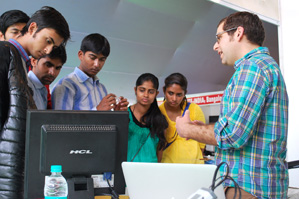Guest post: RoboLobster goes to India

This post was written by one of my favorite Northeastern grad students, Dan Blustein, who studies biomimetic robots in biology professor Joe Ayers’ lab. Read on for details on his trip to India, where he showed off those robots at a student-run conference and picked up a few life lessons along the way.
Last week I took a menagerie of robot animals to India. The robots were the featured attraction of my exhibition at a student-run technology conference on the campus of the Indian Institute of Technology in Kanpur. And after surviving the 7,300 mile journey to India from Boston, RoboLobster, RoboLamprey, and RoboBee were ready for show time.
I was invited by the conference organizers to show off our latest biomimetic robot technology on underwater and flying robots. These are the guys we work on in the lab of biology professor Joseph Ayers at Northeastern University’s Marine Science Center in Nahant, Mass., just a short drive north of Boston and where I’m a doctoral student.
We study animals like lobsters and honeybees and then we mimic what we find to build robot models. We try to account for everything from the animal’s body plan and movements to how the nervous system controls those movements and behaviors.
The main aim of our work is to run nervous system simulations on our robots that we can manipulate. It can be difficult to experimentally change the nervous system in a freely behaving animal, but we can easily change the nervous systems that run our robot animals to test out different neuroscience hypotheses. If a lobster gets stuck out in the wild, it can kick, wiggle and squirm its way to freedom, but how does it do that? We’re testing out different nervous system structures on our robots to help us figure out how animals, like the squirming lobster, adapt their behavior to their environments.
For three straight days an endless stream of conference attendees visited my biomimetic robot booth, snapping photos and asking a range of questions about the robots: “What does it do?” “Why does it look like a lobster?” “How deep can it go?” I did my best to explain the science behind the robots and our approach to what we call synthetic neuroscience.
Here I am at my booth before the crowds arrived:
The students at IIT Kanpur were extremely welcoming, in particular Vaibhav, a freshman chemical engineering major who served as my hospitality host, escorting me everywhere and getting me anything I needed.
I was most impressed by how much the students at IIT Kanpur seemed to appreciate and admire scientific work. Every night at 10:30 pm there was a scientific talk by a preeminent scientist. Students would line up for hours before the event to get a seat in the auditorium to hear about quantum mechanics, black holes or some other lofty subject.
And the entertainment at the conference was over-the-top. Every day there were concerts and shows ranging from sword swallowers to Bollywood stars. A rock concert my first night in Kanpur was particularly memorable as I danced along with hundreds of Indian college students to the electric violin riffs of a cover of The Who’s Baba O’Riley.
After my time at the conference, I ventured off on the tourist circuit visiting the Taj Mahal, the rambling markets of Delhi, temples of many varieties, and Jaipur, the Pink City complete with a Water Palace and a fort accessible by elephant. Here I am at a Holi Festival pre-party we came across on the road to Jaipur:
Getting the robots back to the U.S. turned into quite the adventure. After leaving the conference site, I learned of some issues with customs in shipping the robots home. Here’s me trying to figure out customs regulations from a Mughal fort in Agra:
After giving up on shipping the robots to the U.S., I decided to take them home with me on the plane. One minor problem: I was in Delhi and the robots were six hours away at the conference site. Luckily, two students going through Delhi for spring break were able to hand off the robots during a quick train station layover. And while RoboLobster and RoboLamprey are designed to operate underwater, we needed to keep their transport box dry from the Delhi rains using a plastic covering. Since the markets were closed, we had to buy plastic sheets off the top of a local driver’s rickshaw:
Luckily the rest of the journey home went smoothly and the robots made it to Boston as checked luggage without a problem. I wonder what these x-ray screeners thought when they peered through the black box containing the robot animals:
 My time in India was intense. It’s a country constantly buzzing with activity and filled with the unexpected. A whirlwind exhibition experience left me extremely impressed by the students of IIT Kanpur; their admiration of scientific discovery was refreshing. And my post-conference touring gave me a glimpse of India – its history, culture and nature. With just a small taste of the country I really hope to return to see more of this vibrant place. And hopefully I’ll get to go back and show off our robots again someday.
My time in India was intense. It’s a country constantly buzzing with activity and filled with the unexpected. A whirlwind exhibition experience left me extremely impressed by the students of IIT Kanpur; their admiration of scientific discovery was refreshing. And my post-conference touring gave me a glimpse of India – its history, culture and nature. With just a small taste of the country I really hope to return to see more of this vibrant place. And hopefully I’ll get to go back and show off our robots again someday.
All photos courtesy of Dan Blustein.











